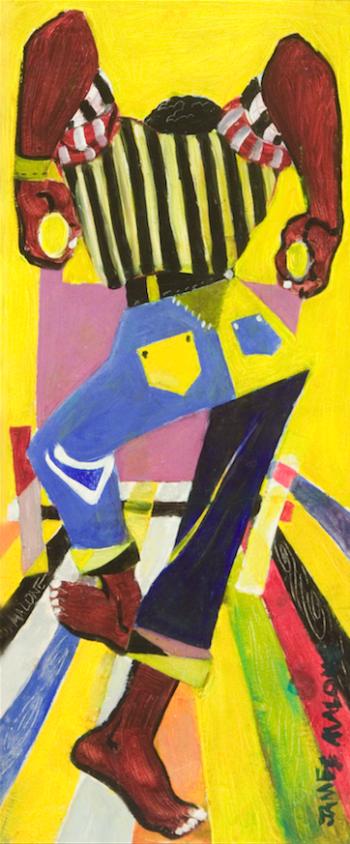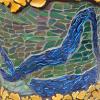History and Tradition: African-American Art at the Georgia Museum
Art Notes

Michael Ellison
Reflecting shifting cultural and political landscapes for African-American artists, “Expanding Tradition: Selections from the Larry D. and Brenda A. Thompson Collection” is an astounding exhibition diverse in style and rich in history. While some images are tied to pivotal eras like the Great Depression and Civil Rights Movement, many others touch on complex issues regarding race, gender and class. Currently on view at the Georgia Museum of Art through Sunday, May 7, the exhibition includes nearly 60 works selected from the couple’s collection, a decades-long passion.
Following the appearance of the Thompsons’ previous traveling exhibition, “Tradition Redefined,” the Atlanta-based couple decided to donate 100 works to the museum in 2012, a major announcement that coincided with UGA’s celebration of the 50th anniversary of its desegregation. “Expanding Tradition” continues this commitment toward fostering inclusivity in galleries and ensuring that the narratives of African Americans are preserved within art history. It also serves as the inaugural exhibition for Dr. Shawnya Harris, the museum’s new Larry D. and Brenda A. Thompson Curator of African-American and African Diasporic Art, an endowed position established to expand scholarships for artists of color.
“Expanding Tradition” offers a survey of African-American art history through works spanning from the late 19th Century through the contemporary era. Impactful works by historical artists—Elizabeth Catlett, Charles Sebree, Wilmer Jennings and Rose Piper—can be found steps away from pieces by living artists like Kara Walker, Amalia Amaki, Willie Cole and Preston Sampson. James Hiram Malone, whose painting “The Stevedore” appears on this week’s cover of Flagpole, was born nearby in Winterville and served as a community activist and crucial member of the Atlanta arts scene for many years.

"The Stevedore" by James Hiram Malone
Both the exhibition and its accompanying catalog include biographical paragraphs—a rare practice for wall labels, but one that offers valuable insight into the personal backgrounds, academic achievements and cultural contributions of each artist, whom history has regretfully overlooked in many cases. Many of these artists have doubled as educators, activists and pioneers, and recognizing their hardships, efforts and accomplishments is essential to the larger discussion.
“Expanding Traditions” flows in a loosely chronological way, often grouping works together that share a commonality in subject matter or approach. Many of the artists were employed through the Works Progress Administration’s Federal Art Project, which supported artistic production during the Great Depression. This placed some artists in a position where they could depict the experiences of marginalized groups. Hale Woodruff’s “Poverty and Prosperity,” for example, depicts a man idly seated on a waterfront with skyscrapers in the distance, suggesting the disappointment felt by many African Americans who migrated to northern cities in hopes of better opportunities.
A section for abstraction is full of colorful and intriguing creations, like Freddie Styles’ “Working Roots” painting, which utilized plant roots to make a dense growth of gestural markings over a red canvas—a process suggesting connections to Georgia red clay, as well as African spiritual practices. The exhibition closes out with a collection of contemporary works, many of which take on mixed-media forms, like Benny Andrew’s haunting “Poverty,” a larger-than-life but gaunt figure wearing painted fabric and eating a meager meal collaged from scraps of painted material.
Reflecting the museum’s dedication to presenting solo exhibitions by under-recognized African-American artists, “Michael Ellison: Urban Impressions” showcases block prints and collage works by the Atlanta-based printmaker and educator. Also curated by Harris, the exhibition borrows most of its pieces from the Thompsons’ collection. On view Saturday, Feb. 18 through Sunday, May 21, the works represent an important slice of history for Southern printmaking.
Born in New York City, Ellison grew up in the Collier Heights neighborhood of Atlanta and spent most of his life in Georgia. After studying printmaking at the Atlanta College of Art on the GI Bill, he went on to graduate with a master’s degree in visual arts from Georgia State University. As an educator, he taught at South Carolina State College, Claflin College and the Atlanta College of Art. Ellison’s artistic career was challenged after he was severely injured during an electrical fire in 1991, but he re-learned his processes and continued creating work—including a mural in Atlanta’s Five Points and multiple solo exhibitions—throughout the following decade until his death in 2001.
Demonstrating a strong attachment to place, Ellison’s work frequently depicts urban landscapes and scenes from Atlanta’s black community. Observed through the cluster of people shuffling onto the elevator depicted in “Ding,” or the people patiently reading publications in the checkerboard-floored “Waiting Room,” Ellison has a unique ability to capture the camaraderie between strangers sharing mundane experiences. Other images focus on personal relationships, like a table of “Miss Millie’s Friends” gathered around to enjoy slices of birthday cake and Coke, or couples barbecuing and taking leisurely strolls through the park in “Cythera Revisited.” Bursts of bold colors like magenta, chartreuse and orange catch the eye, while thick layers of ink create the illusion of texture.
Larry and Brenda Thompson will visit the museum for Conversation on Collecting, a discussion focusing on the importance of partnerships between academic institutions and private collectors in increasing the awareness of African-American artists, on Thursday, Feb. 23 at 5:30 p.m.
The following evening from 6–9 p.m., the museum will host its annual Black History Month dinner. Titled “Hallowed Ground: Sites of African-American Memory,” the evening includes a gallery tour, catered dinner, live music by the UGA African-American Choral Ensemble and an awards ceremony honoring Larry Walker and Althea Natalga Sumpter. Tickets for the event, which typically sells out, can be reserved online.
Additional programming for “Expanding Tradition” includes a Tour at Two on Feb. 15 at 2 p.m. and an Artful Conversation on Mar. 22 at 2 p.m. The event lineup for “Urban Impressions” features a Tour at Two on Mar. 15 at 2 p.m., an Artful Conversation on Apr. 26 at 2 p.m. and a Toddler Tuesday on May 9 at 10 a.m.
Keywords
More by Jessica Smith
-

Art Around Town
A list of local art exhibits.
-

-

Art Around Town
A list of local art exhibits.









comments